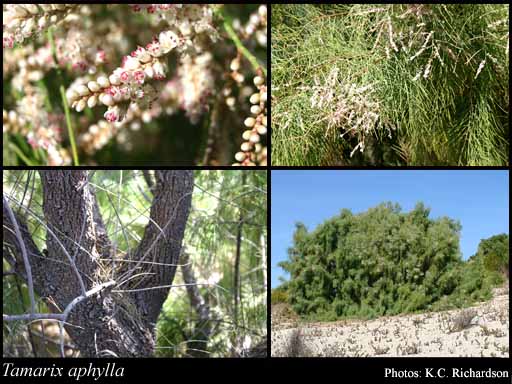- Reference
- Deut.Fl. 641 (1882)
- Conservation Code
- Not threatened
- Naturalised Status
- Alien to Western Australia
- Name Status
- Current
Tree, to 12 m high. Fl. pink-white, Feb or May. Along river banks.







Distribution
- IBRA Regions
- Avon Wheatbelt, Carnarvon, Central Kimberley, Geraldton Sandplains, Mallee, Pilbara, Swan Coastal Plain.
- IBRA Subregions
- Cape Range, Geraldton Hills, Hamersley, Hart, Katanning, Perth, Western Mallee, Wooramel.
- IMCRA Regions
- Central West Coast.
- Local Government Areas (LGAs)
- Ashburton, Beverley, Carnarvon, Cockburn, Exmouth, Greater Geraldton, Halls Creek, Kulin, Rockingham, Shark Bay, Toodyay, Wanneroo.
Management Notes (for the Swan NRM Region)
General Biology. Growth form. Tree. Life form. Annual. Reproduction. Seed and vegetative. Dispersal. Seed dispersal by wind, water and animals.. Time to first flowering. Third Year. Seedbank persistence. Seed die quickly if not kept moist.. Fire response. Fire adapted species that resprouts from the roots crown after fire..
Notes. Flowers are small with petals about 2 mm long, stalkless, pale-pink or whitish, and borne in elongated clusters, 3-6 cm long near the tips of the branches. Athel Tree fruits are bell shaped and 2-3 cm long..
Additional information. Origin. Native of Northern Africa and Asia (Morocco, Algeria, Egypt, Kenya, Middle East). History of use/introduction. Introduced in the 1930s for use as shade, wind break and erosion control around rural South Australia, New South Wales, Queensland, Western Australia and the Barkly Tablelands and Alice Spring regions.. Similar exotic species. Tamarix paviflora, Tamarix ramosissima.. Similar native species. Resembles native she-oaks (Casuarina and Allocasuarina species.
Suggested method of management and control. Mechanical removal of seedlings and trees with attention given to removing as much of the root system as possible. Suitable natives should be sown in placec to outcompete any potential regrowth. Chemical control is also possible in areas susceptible to erosion. Herbecide can be applied by frilling the bark (small notches 5 cm apart), the cut stump technique or basal bark technique for smaller trees. Biological control has been employed in the USA, but has not yet been investigated in Australia. Read the manufacturers' labels and material safety data sheets before using herbicides. For further information consult the Australian Pesticides and Veterinary Medicines Authority to determine the status of permits for your situation or state.
Management Calendar
| Calendar Type | Jan | Feb | Mar | Apr | May | Jun | Jul | Aug | Sep | Oct | Nov | Dec | Comments |
|---|---|---|---|---|---|---|---|---|---|---|---|---|---|
| Germination | O | O | Y | Y | Y | O | O | O | O | O | O | O | |
| Optimum Treatment | Y | Y | Y | Y | Y | Y | Y | Y | Y | Y | Y | Y | |
| Flowering | Y | Y | Y | Y |
Legend: Y = Yes, regularly, O = Occasionally, U = Uncertain, referred by others but not confirmed.
References
- (2019) Tamarix aphylla. URL: www.fs.fed.us/database/feis/plants/tree/tamaph/all.html - Accessed June 2019.
- Brown, K. & Brooks, K. (2002) Bushland Weeds: A Practical Guide to their Management. Environmental Weeds Action Network, Greenwood.
- Brown, K. & Brooks, K. (2002) Bushland Weeds: A Practical Guide to their Management. Environmental Weeds Action Network, Greenwood.
- CRC Weed Management (2003) Athel pine or tamarisk (Tamarix aphylla)..
- CRC Weed Management (2008) Weed management guide - Athel Pine (Tamarix aphylla). The CRC for Australian Weed Management URL: http://www.weeds.crc.org.au/weed_management/indiv_species_a.html#athelpine - Accessed February 2008.
- CRC Weed Management (2008) Weed management guide - Athel Pine (Tamarix aphylla). The CRC for Australian Weed Management URL: http://www.weeds.crc.org.au/weed_management/indiv_species_a.html#athelpine - Accessed February 2008.
- DeLoach, C.J., Lewis, P.A., Herr, J.C., Carruthers, R.I., Tracy, J.L. & Johnson, J (2003) Host Specificity of the Leaf Beetle, Diorhabda elongata (Coleoptera: Chrysomelidae) from Asia, a Biological Control Agent for Saltcedars (Tamarix: Tamaricaceae) in the Western United States. Biological Control, 27 (2): 117-147 Elsevier Science, USA.
- Gouldthorpe, J. (2008) Athel Pine. National Best Practice Management Manual. Northern Territory Government, Northern Territory.
- Gouldthorpe, J. (2008) Athel Pine. National Best Practice Management Manual. Northern Territory Government, Northern Territory.
- Griffin, G.F., Smith, D.M.S., Morton, S.R., Allen, G.E. & Masters, K.A. (1989) Status and Implications of the Invasion of Tamarisk (Tamarisk aphylla) on the Finke River, Northern Territory. Journal of Environmental Management, 29 (4): 297-315 Elsevier.
- Hussey, B.M.J., Keighery, G.J., Dodd, J., Lloyd, S.G. & Cousens, R.D. (2007) Western Weeds. A guide to the weeds of Western Australia. 2nd Edition. The Plant Protection Society of Western Australia, Victoria Park.
- Hussey, B.M.J., Keighery, G.J., Dodd, J., Lloyd, S.G. & Cousens, R.D. (2007) Western Weeds. A guide to the weeds of Western Australia. 2nd Edition. The Plant Protection Society of Western Australia, Victoria Park.
- Meyers-Rice, B. (1997) Weed notes Tamarix spp. The Nature Conservancy, Arlington, USA. URL: http://tncweeds.ucdavis.edu/esadocs.html - Accessed December 2007.
- Muzika, R. & Swearingen, J.M. (1997) Saltcedar, Tamarix aphylla, T. chinensis, T. gallica. Alien plant invaders of natural areas - trees. URL: http://www.nps.gov/plants/alien/trees.htm - Accessed December 2007.
- Navie, S. & Adkins, S. (2008) Environmental Weeds of Australia, An interactive identification and information resource for over 1000 invasive plants. Centre for Biological Information Technology, The University of Queensland.
- Parsons, W.T. & Cuthbertson, E.G. (2001) Noxious weeds of Australia. 2nd Edition. CSIRO Publishing, Collingwood.
- Tesky, J.L. (1992) Tamarix aphylla. In U.S. Department of Agriculture, Forest Service, Rocky Mountain Research Station, Fire Sciences Laboratory. Fire Effects Information System. URL: http://www.fs.fed.us/database/feis/ - Accessed December 2007.
- Zouhar, K. (2003) Tamarix spp. In: Fire Effects Information System, [Online]. U.S. Department of Agriculture, Forest Service, Rocky Mountain Research Station, Fire Sciences Laboratory URL: http://www.fs.fed.us/database/feis/plants/tree/tamspp/all.html - Accessed October 2009.